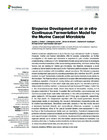Stepwise Development of an in vitro Continuous Fermentation Model for the Murine Caecal Microbiota
dc.contributor.author
Poeker, Sophie A.
dc.contributor.author
Lacroix, Christophe
dc.contributor.author
de Wouters, Tomas
dc.contributor.author
Spalinger, Marianne R.
dc.contributor.author
Scharl, Michael
dc.contributor.author
Geirnaert, Annelies
dc.date.accessioned
2019-06-11T14:55:05Z
dc.date.available
2019-06-11T02:14:02Z
dc.date.available
2019-06-11T14:55:05Z
dc.date.issued
2019-05
dc.identifier.issn
1664-302X
dc.identifier.other
10.3389/fmicb.2019.01166
en_US
dc.identifier.uri
http://hdl.handle.net/20.500.11850/346530
dc.identifier.doi
10.3929/ethz-b-000346530
dc.description.abstract
Murine models are valuable tools to study the role of gut microbiota in health or disease. However, murine and human microbiota differ in species composition, so further investigation of the murine gut microbiota is important to gain a better mechanistic understanding. Continuous in vitro fermentation models are powerful tools to investigate microbe-microbe interactions while circumventing animal testing and host confounding factors, but are lacking for murine gut microbiota. We therefore developed a novel continuous fermentation model based on the PolyFermS platform adapted to the murine caecum and inoculated with immobilized caecal microbiota. We followed a stepwise model development approach by adjusting parameters [pH, retention time (RT), growth medium] to reach fermentation metabolite profiles and marker bacterial levels similar to the inoculum. The final model had a stable and inoculum-alike fermentation profile during continuous operation. A lower pH during startup and continuous operation stimulated bacterial fermentation (115 mM short-chain fatty acids at pH 7 to 159 mM at pH 6.5). Adjustments to nutritive medium, a decreased pH and increased RT helped control the in vitro Enterobacteriaceae levels, which often bloom in fermentation models, to 6.6 log gene copies/mL in final model. In parallel, the Lactobacillus, Lachnospiraceae, and Ruminococcaceae levels were better maintained in vitro with concentrations of 8.5 log gene copies/mL, 8.8 log gene copies/mL and 7.5 log gene copies/mL, respectively, in the final model. An independent repetition with final model parameters showed reproducible results in maintaining the inoculum fermentation metabolite profile and its marker bacterial levels. Microbiota community analysis of the final model showed a decreased bacterial diversity and compositional differences compared to caecal inoculum microbiota. Most of the caecal bacterial families were represented in vitro, but taxa of the Muribaculaceae family were not maintained. Functional metagenomics prediction showed conserved metabolic and functional KEGG pathways between in vitro and caecal inoculum microbiota. To conclude, we showed that a rational and stepwise approach allowed us to model in vitro the murine caecal microbiota and functions. Our model is a first step to develop murine microbiota model systems and offers the potential to study microbiota functionality and structure ex vivo.
en_US
dc.format
application/pdf
en_US
dc.language.iso
en
en_US
dc.publisher
Frontiers Media
dc.rights.uri
http://creativecommons.org/licenses/by/4.0/
dc.subject
microbiome
en_US
dc.subject
C57BL/6
en_US
dc.subject
mouse caecum
en_US
dc.subject
cultivation
en_US
dc.subject
in vitro model
en_US
dc.title
Stepwise Development of an in vitro Continuous Fermentation Model for the Murine Caecal Microbiota
en_US
dc.type
Journal Article
dc.rights.license
Creative Commons Attribution 4.0 International
dc.date.published
2019-05-29
ethz.journal.title
Frontiers in Microbiology
ethz.journal.volume
10
en_US
ethz.journal.abbreviated
Front Microbiol
ethz.pages.start
1166
en_US
ethz.size
14 p.
en_US
ethz.version.deposit
publishedVersion
en_US
ethz.grant
The Microbe-Host Interface: Molecular Mechanisms Mediating Protective and Pathological Innate and Adaptive Immune Responses within the Gut
en_US
ethz.identifier.wos
ethz.publication.place
Lausanne
ethz.publication.status
published
en_US
ethz.leitzahl
ETH Zürich::00002 - ETH Zürich::00012 - Lehre und Forschung::00007 - Departemente::02070 - Dep. Gesundheitswiss. und Technologie / Dep. of Health Sciences and Technology::02701 - Inst.f. Lebensmittelwiss.,Ernährung,Ges. / Institute of Food, Nutrition, and Health::03626 - Lacroix, Christophe (emeritus) / Lacroix, Christophe (emeritus)
en_US
ethz.leitzahl.certified
ETH Zürich::00002 - ETH Zürich::00012 - Lehre und Forschung::00007 - Departemente::02070 - Dep. Gesundheitswiss. und Technologie / Dep. of Health Sciences and Technology::02701 - Inst.f. Lebensmittelwiss.,Ernährung,Ges. / Institute of Food, Nutrition, and Health::03626 - Lacroix, Christophe (emeritus) / Lacroix, Christophe (emeritus)
ethz.grant.agreementno
154488
ethz.grant.fundername
SNF
ethz.grant.funderDoi
10.13039/501100001711
ethz.grant.program
Projektförderung in Biologie und Medizin (Abteilung III)
ethz.date.deposited
2019-06-11T02:14:05Z
ethz.source
WOS
ethz.eth
yes
en_US
ethz.availability
Open access
en_US
ethz.rosetta.installDate
2019-06-11T14:55:21Z
ethz.rosetta.lastUpdated
2024-02-02T08:16:38Z
ethz.rosetta.versionExported
true
ethz.COinS
ctx_ver=Z39.88-2004&rft_val_fmt=info:ofi/fmt:kev:mtx:journal&rft.atitle=Stepwise%20Development%20of%20an%20in%20vitro%20Continuous%20Fermentation%20Model%20for%20the%20Murine%20Caecal%20Microbiota&rft.jtitle=Frontiers%20in%20Microbiology&rft.date=2019-05&rft.volume=10&rft.spage=1166&rft.issn=1664-302X&rft.au=Poeker,%20Sophie%20A.&Lacroix,%20Christophe&de%20Wouters,%20Tomas&Spalinger,%20Marianne%20R.&Scharl,%20Michael&rft.genre=article&rft_id=info:doi/10.3389/fmicb.2019.01166&
Files in this item
Publication type
-
Journal Article [128813]

